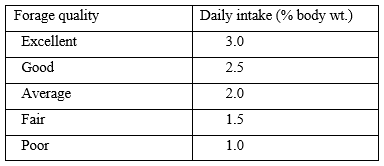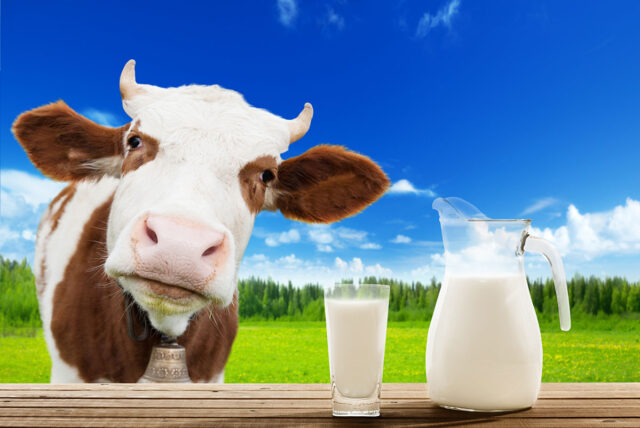1. Introduction
A. Milk and milk products:
1) In the American diet? Annual per capita consumption of about 280 kg of dairy products, and they supply about 75% of dietary Ca. Also, an important source of other nutrients, i.e., energy, protein, vitamins, and other minerals.
2) Other countries? Consumption could be 50 to 100% higher than the US in some countries, and world consumption is more than 100 kg per capita even when including those countries with consumption of much fewer milk products.
B. In the US, about 9.5 million dairy cows, each producing an average of 7,500 kg milk/year. nutrients, i.e., energy, protein, vitamins, and other minerals.
C. Systems used in the US? The type of system used is partially dependent on the geographic area and availability of feedstuffs.
1) Pasture system – Traditional system is continuing in areas of a sparse human population.
2) Dry lot systems with minimum roughage and higher quantities of less bulky feeds such as concentrates – Being used in areas surrounding.
D. Dairy cows need to consume a lot of feed/nutrients to achieve today’s expected milk production and feed represents about 50% of the total production costs.
1) Thus, a feeding program, more than any other single factor, can determine the productivity of lactating dairy cows & profitability.
2) About 75% of the differences in milk production between cows is determined by environmental factors, with feed making up the largest portion.
3) At peak production, may require 3 to 10 times as much protein & energy vs. late gestation, but the cow’s appetite usually lags behind her nutritional needs.
2. The lactation and Gestation Cycle
A. The relationships among milk production, DM intake, and body wt changes.
B. Milk production – Increases rapidly and reaches peak 6-8 wk after calving.
C. Feed intake – Lags behind milk production, i.e., maximum DM intake does not reach until 12 to 15 wk after calving.
D. Body reserves – Make up the difference in the need & supply by mobilizing body stores. Often lose 90 to 135 kg of body wt!.
3. Forages
A. The cow cannot consume enough forage to meet its nutrient needs during lactation, even though they have a considerable capacity!
1) Daily intake for forages is estimated based on body wt and forage quality.
3) Estimated silage intake (as-fed basis) – 3 lb for each l lb of expected hay intake.
4) Pasture intake – Usually, higher than silage at the same dry matter percentages.
B. Increase forage intake by feeding several times/days and providing a variety of forages?!

4. Concentrates
A. A concentrate mixture contains grains, mill feeds, protein supplements, and minerals
1) The kind of mixture to feed will vary with the kind of forage fed (e.g., a high-protein mix will be needed with a low-protein forage), availability, and cost.
2) The amount of concentrate mix fed will depend on:
a) The amount of forage consumed.
b) The amount of milk produced.
c) The composition (fat %) of the milk produced.
3) Limit % of concentrates to a maximum of about 60% regardless of the comparative cost of and roughages.
4) Rations with more than 60% of concentrates may result in changes in the proportion of ruminal VFA, which in turn can result in the reduction of milk fat.
B. Intake of a concentrate mixture is affected by palatability and the time available to consume concentrates in the barn or milking parlor.
C. Depends, but tend to overfeed the low producer and underfeed the high producer?!
5. Phase Feeding Program/Feeding Guidelines
A. Feeding periods/phases can be divided into four or five – The Lactation and Gestation Cycle.”
1) Phase 1 – First 10 wk of lactation. Peak milk production & body stores are being used to make up deficits in nutrient intake.
2) Phase 2 – 10 to 20 wk or so of lactation. Maximum DM intake and the intake is in balance with the needs?!
3) Phase 3 – The intake exceeds the needs. The main period is to restore body reserves for the next lactation.
4) Phases 4 & 5 – Dry period, and can be considered as only one phase, but:
a) Phase 4 – Most of the dry period, and replete body reserves & regenerate secretory tissues for the next lactation.
b) Phase 5 – The last 1 to 3 wk of pre-partum. Start increasing grain intake as a means to prepare the rumen for the increased nutritional deficiencies.
B. Dry period & bred heifers (Phases 4 & 5)
1) Cows need a short dry period as rest to prepare for the next lactation. The optimum dry period would be 6 to 8 wk
a) Shorter that 40 d? – Not enough time for udder regeneration, thus may reduce the production rate.
b) Longer than 60 d? – Do not increase the production, and may result in excess body condition & calving difficulties.
2) Bred heifers
a) Nutrient needs are slightly higher vs. dry cows of similar size – Still growing.
b) Need some grains along with forages during the last 3 to 4 months of gestation to support growth & provide nutrients for fetus.
c) Quality of forage may not be as critical during the dry period, but cows need sufficient feed to support both the unborn calf and to meet body reserves not replaced in the previous period.
3) “Fat cow syndrome” – Feeding high levels of corn silage or grains may cause excess fat deposits in the liver area:
a) Characterized by high blood lipids & fatty livers.
b) May result in calving difficulties, displaced abomasum, ketosis, and others.
4) Cows need a short dry period as rest to prepare for the next lactation. The optimum dry period would be 6 to 8 wk.
a) Shorter than 40 – Not enough time for udder regeneration thus may reduce the production rate.
b) Longer than 60 d – Do not increase the production, and may result in excess body condition & calving difficulties.
5) About 2 wk before calving, increase grain feeding, so cows are consuming 12 to 16 lb grain/day at calving (1% of body weight).
a) Helps cows get accustomed to high grain intake needed after calving, and can reduce the occurrence of ketosis during lactation.
b) Best to increase the amount of grains gradually, which may minimize the chance for milk fever. Most grain mixes have a more desirable Ca to P ratio?
c) Feed a low-Ca ration (< 0.20%, reduce Ca intake to 14 to 18 g/d) 2 wk before parturition to those with milk fever problems may be beneficial?!
d) Also, feed a diet with a negative dietary electrolyte balance (-10 to -15 mEQ/100 g DM) may alleviate milk fever problems.
C. Peak milk production (Phase 1)
1) Cows should be brought into peak milk production as soon as possible after calving. Can be done by feeding slightly more grain than recommended until there is no increase in production & then adjusting the amount of grain accordingly.
2) Milk production increases rapidly, peaking at 6 to 8 wk after calving.
3) The most critical period for a dairy cow is “from parturition until peak milk production:”
a) Objective for this phase – To increase feed intake as rapidly as possible.
b) Increase grain intake by 1 to 2 lb per day after calving to meet the energy needs.
c) May want to avoid excessive grain (> 65% total DM) and maintain 17 to 19% acid detergent fiber in diet to reduce rumen disorders.
e) More ruminally undegradable protein source (i.e., bypass protein) might be recommended for high-producing cows in early lactation. The protein need of cows producing up to 5 kg/100 kg body wt can be met by rumen microbial protein, plus normal amount of bypass protein, but cows producing more would benefit from additional bypass protein.
f) Limit urea to 0.2 to 0.4 lb/day.
g) Buffers, such as Na bicarbonate alone or in combination with Mg oxide, may be beneficial during the early lactation – This May aid in maintaining ruminal pH, which minimizes acidosis, reduces digestive upsets, and results in increased DM intake.
D. Peak dry matter intake (Phase 2)
1) To maintain peak milk production, should achieve maximum DM intake as early in lactation as possible. Usually, reached at 12 to 14 wk
2) With maximum DM intake:
a) Can minimize the negative nutrient balance experienced during the early lactation.
b) A conception rate is greater for ones in positive energy balance, which is an important consideration because cows are usually being bred during this phase.
c) Maximum DM intake will likely to reach 3.5 to 4% of body wt for most cows, but some variations. (Some may consume as much as 5% of body wt)
d) Grain intake may reach 2½% of cow’s body wt, and forage intake (DM) should be at least 1-1¼% of cow’s body wt to maintain rumen function and milk-fat test.
e) Should feed forages and grain several times daily.
E. Mid to late lactation (Phase 3)
1) Should keep in mind that young cows are still growing, i.e., the nutrient requirements for growth are 20% of the maintenance requirements for 2-yr-olds and 10% maintenance for 3-yr-olds.
2) The NPN may be well utilized, thus can use urea (0.4 to 0.5 lb/cow/day) if needed to, again, reduce feed costs.
3) Some Considerations in Feeding for Milk Production
A. Optimizing feed intake during lactation
1) Water content of feed:
a) Important consideration when using ensiled or fresh forages, or other high moisture feedstuffs such as high-moisture corn, wet brewers grains, liquid whey.
b) The effect on DM intake is less when water is present in the form of fresh forages than it is in the form of silage or other fermented feeds – e.g., DM intake can be reduced when the moisture content exceeds 50% from ensiled feeds, perhaps, partially caused by chemicals in the feed rather than by moisture per se?
2) Frequency of feeding:
a) A minimum of four daily feedings – Alternating between forages and concentrates might be the best to increase intake.
b) Total mixed ration – Feeding frequency may not increase DM intake, but may help to stabilize rumen fermentation though!
3) High-producing cows Obviously, necessary to maximize feed intake:
a) Should have access to feeds for at least 18 to 20 hr/d? May consume their daily intake in 12 to 22 meals & increase the intake!
b) Consuming more than 4.5 kg of concentrate mix/meal at once can cause acidosis.
c) Many electronic grain feeders are programmed to limit the amount of concentrate consumed by a cow within a short period of time, which would be helpful in alleviating acidosis problems.
d) Most lactation rations will contain 13 to 17% CP and 60 to 70% TDN (0.6 to 0.8 Mcal/lb NEl).
e). Finely ground or pelleted forages or grains should not be fed alone to lactating cattle because it can lower milk fat test.
f). Cows in full production will consume 3 to 5 lb of water (including water in feed) for each l lb of milk produced. Have water available at all times and warm water during winter.
Also, read | Therapeutic Management of Clinical Mastitis in Dairy cattle
Authors:

1* AKANKSHA GUPTA, 2 Shubham Thakur 3 Nishtha Kushwaha
1* P.hd scholar Department of Dairy Cattle Physiology, National Dairy Research Institute Karnal, 132001.
2 P.hd Scholar Department of Animal Nutrition, Lala Lajpat Rai University of Veterinary and Animal Sciences, Hisar, 125004.
3 Nishtha Kushwah Assistant Professor College of Veterinary Sciences and Animal
husbandry Mhow, 453441
*Corresponding author: akanksha25974@gmail.com















